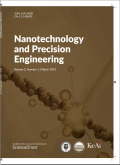- 钛学术文献服务平台 \
- 学术期刊 \
- 工业技术期刊 \
- 机械与仪表工业期刊 \
- 纳米技术与精密工程(英文)期刊 \
Nanostructured grinding wheels for ultra-precision engineering applications
Nanostructured grinding wheels for ultra-precision engineering applications
基本信息来源于合作网站,原文需代理用户跳转至来源网站获取
摘要:
Manufacturers face challenges when dealing with abrasives that lose roundness, wear excessively, and suffer from pitting of the sur-face of the grinding wheel that needs rectification using dressing techniques. Nanostructured abrasive grits manufactured by hybrid fusion processes and by sintering/extrusion/printing processes are found to reduce pitting quite significantly. The phenomenon of wheel collapse is increasing and cycle times developed during the grinding of aerospace alloys are much smaller compared to using con-ventional materials. This paper reviews the phenomenon of wheel collapse induced by pitting and takes a critical look at the produc-tion and analysis of hybrid fused and printed/sintered abrasives. A mathematical analysis is carried out of the diffusion of primary and secondary phases due to mechanical and ultrasonic agitation with the aim of producing abrasive grits with improved strength and retention. Current developments in extruded, printed, and sintered grits for use in precision grinding applications are critically reviewed. The paper concludes by explaining how such abrasives are used in practice by industrial manufacturers of high-precision products.

推荐文章
Teamcenter Engineering中文件自动签字技术的研究与实现
Teamcenter Engineering
VBA
ActionHandler
ITK
自动签字
新型磷脂酶Lecitase Ultra用于大豆油脱胶的研究
油脂脱胶
磷脂酶A1
Lecitase Ultra
大豆油
Ultra DMA模式下硬盘数据加密系统的设计及FPGA实现
极端直接存储器存取模式
硬盘数据加密系统
现场可编程门阵列
内容分析
关键词云
关键词热度
相关文献总数
(/次)
(/年)
文献信息
| 篇名 | Nanostructured grinding wheels for ultra-precision engineering applications | ||
| 来源期刊 | 纳米技术与精密工程(英文版) | 学科 | |
| 关键词 | |||
| 年,卷(期) | 2021,(3) | 所属期刊栏目 | REVIEW ARTICLES |
| 研究方向 | 页码范围 | 63-75 | |
| 页数 | 13页 | 分类号 | |
| 字数 | 语种 | 英文 | |
| DOI | 10.1063/10.0005570 | ||
五维指标
引文网络
引文网络
二级参考文献 (0)
共引文献 (0)
参考文献 (16)
节点文献
引证文献 (0)
同被引文献 (0)
二级引证文献 (0)
1992(1)
- 参考文献(1)
- 二级参考文献(0)
1997(1)
- 参考文献(1)
- 二级参考文献(0)
2004(1)
- 参考文献(1)
- 二级参考文献(0)
2006(1)
- 参考文献(1)
- 二级参考文献(0)
2009(3)
- 参考文献(3)
- 二级参考文献(0)
2011(1)
- 参考文献(1)
- 二级参考文献(0)
2013(1)
- 参考文献(1)
- 二级参考文献(0)
2014(2)
- 参考文献(2)
- 二级参考文献(0)
2015(1)
- 参考文献(1)
- 二级参考文献(0)
2016(1)
- 参考文献(1)
- 二级参考文献(0)
2017(2)
- 参考文献(2)
- 二级参考文献(0)
2020(1)
- 参考文献(1)
- 二级参考文献(0)
2021(0)
- 参考文献(0)
- 二级参考文献(0)
- 引证文献(0)
- 二级引证文献(0)
引文网络交叉学科
相关学者/机构
期刊影响力
纳米技术与精密工程(英文)
主办单位:
天津大学
中国微米纳米技术学会
出版周期:
季刊
ISSN:
1672-6030
CN:
12-1458/03
开本:
出版地:
天津市南开区卫津路92号
邮发代号:
创刊时间:
语种:
eng
出版文献量(篇)
1315
总下载数(次)
2
总被引数(次)
8103
期刊文献
相关文献
推荐文献
- 期刊分类
- 期刊(年)
- 期刊(期)
- 期刊推荐
一般工业技术
交通运输
军事科技
冶金工业
动力工程
化学工业
原子能技术
大学学报
建筑科学
无线电电子学与电信技术
机械与仪表工业
水利工程
环境科学与安全科学
电工技术
石油与天然气工业
矿业工程
自动化技术与计算机技术
航空航天
轻工业与手工业
金属学与金属工艺
纳米技术与精密工程(英文)2022
纳米技术与精密工程(英文)2021
纳米技术与精密工程(英文)2020
纳米技术与精密工程(英文)2019
纳米技术与精密工程(英文)2018
纳米技术与精密工程(英文)2017
纳米技术与精密工程(英文)2016
纳米技术与精密工程(英文)2015
纳米技术与精密工程(英文)2014
纳米技术与精密工程(英文)2013
纳米技术与精密工程(英文)2012
纳米技术与精密工程(英文)2011
纳米技术与精密工程(英文)2010
纳米技术与精密工程(英文)2009
纳米技术与精密工程(英文)2008
纳米技术与精密工程(英文)2007
纳米技术与精密工程(英文)2006
纳米技术与精密工程(英文)2005
纳米技术与精密工程(英文)2004
纳米技术与精密工程(英文)2003

 免费查重
免费查重










